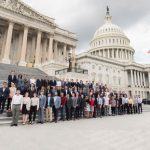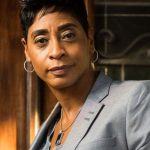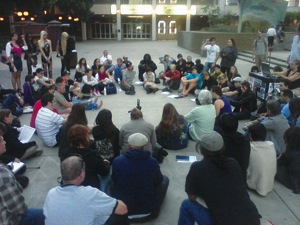
It’s a Sunday afternoon in mid-November, and I’m walking into downtown’s Civic Center Plaza, renamed Freedom Square by occupiers, members of the larger Occupy Wall Street movement, which is seeking to redress the nation’s economic and political inequality. As I make my way through the jumble of pedestrians, occupiers and police, I find 26-year-old, gay, college student Michael Basillas sitting on a row of stairs, surrounded by a dozen occupiers, speaking through a bull-horn, reading Occupy Wall Street’s “Declaration of the Occupation of New York City,” a list of grievances written by New York occupiers. I turn away, walk a few feet and approach a circle of people sitting near by. Cecile Veillard, 34-year-old, bisexual and president of the San Diego Alliance for Marriage Equality (SAME) is speaking about general Occupy community issues. A few minutes later, I walk to the east side of the square. There I find Michelle “Jersey” Deutsch, 26-year-old, transgender, field director for Canvas for a Cause (CFAC) taking a break from gathering signatures for a petition for the City Council to endorse a space for local occupiers.
Clearly, if anything can be said about this picture, it’s that LGBT individuals are involved in the day-to-day affairs and coordination of the local sect of the Occupy Wall Street movement, known as Occupy San Diego, which began in early October.
“Definitely a high, for me personally, is the LGBT involvement in this movement,” Deutsch said, estimating that approximately 50 percent of the occupiers at the square at any given moment are LGBT (Veillard gives a more conservative figure, guessing that 20-30 percent of occupiers are LGBT).
“It runs very deep,” Veillard said. “There are LGBT people who work at Occupy every day.”
Basillas is one of those people.
“I’ve been so involved that I actually lost my apartment,” he said.
Basillas is now homeless, spending most of his time at the occupation when not at work or school.
In contrast, Veillard and Deutsch visit the occupation a few times every week.
“Now that it has become harder to spend nights there, I come to Occupy about twice a week, especially when there is a protest or meeting planned that I am sympathetic with or interested in,” Veillard said.
Why occupy
But why do local LGBT people participate in Occupy? Many of them, such as Veillard, are active in LGBT and other politically left organizations and see the value in being a part of a larger social justice movement.
“What’s satisfying for me about organizing within Occupy San Diego, versus struggling mainly for LGBT rights, is there is more potential when you are part of a broader movement,” Veillard said. “I think others who’ve been organizing with SAME for a long time feel this way as well.”
Basillas believes that LGBT activists are too focused on single-issue politics and should see how their oppression is related to economic inequality.
“The LGBT community is focused on one thing, one topic and they run with it. They don’t look at the bigger umbrella,” Basillas said. “Right now the focus is on gay marriage, but if they opened up all the horse panels – open it up just a little or take the panels off – they’d see that there are crossovers.
“The same people responsible for Yes on Prop. 8, for preventing couples to get married, are also the people responsible for preventing people from receiving equal pay and health insurance and being able to afford college. It’s all interconnected. It all comes back to the 1 percent,” Basillas said.
For Deutsch, economic inequality, one of the main issues of the Occupy movement, can explain a lot about LGBT oppression.
“What if money were taken out of politics?” Deutsch asks. “So many LGBT movement groups have been so good at grassroots organizing, yet they still lose campaigns.
“They can’t compete with million dollar campaigns,” Deutsch insists.
“Canvas for a Cause has 18,000 members. Those 18,000 people should have a bigger voice than two groups that come together without member sponsorships and some volunteers that say, ‘We have 30 million dollars,’” Deutsch said.
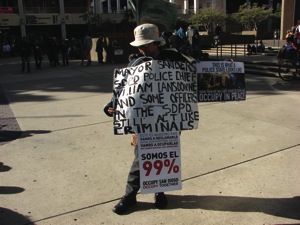
“It’s crazy. What represents the people more?” Deutsch asks. “Economic inequality has oppressed LGBT people for far too long.”
Involvement
Inspired by the call for economic justice and seeing it linked to LGBT oppression, local LGBT occupiers have participated in San Diego Occupy in different ways.
Occupy is operated by members who participate on various committees, including outreach, media, education, among others. LGBT people are well represented on Occupy’s committees, Veillard said. An exact number is hard to pinpoint, she added, since membership in committees are often in a state of flux.
Veillard has attended several different committees – direct action, logistics and another called “people’s defense,” which has since disbanded.
“The purpose of the ‘people’s defense’ committee was to build support for people of Occupy who had been arrested,” Veillard said. Members of the disbanded committee now attend the court dates of those arrested.
Besides LGBT representation on Occupy committees, LGBT occupiers have developed and coordinated specific LGBT-related programming and infrastructure.
Both SAME and CFAC – organizations known for their work on marriage equality – have coordinated the majority of LGBT-related activities and space at Occupy. Both Veillard and Deutsch say their organizations decided to participate in Occupy because their mission or goals parallel Occupy’s.
“It’s very in line with the work CFAC does, as a team of activists, ready for political campaigns, ready to mobilize,” Deutsch said.
“SAME has a long history of joining the call for social justice on many issues,” Veillard said. “We were naturally attracted to Occupy San Diego.”
During the first week of San Diego’s occupation, when police allowed tents in the square, CFAC created an LGBT tent.
“It was a queer safe space, a place to camp, speak out, a library of LGBTQ literature and info,” Deutsch said.
Members of SAME also created a queer friendly tent.
According to Veillard, SAME member Michael Anderson laid a banner over the tent that read Queer Revolution. “He said, ‘OK, there. Now people will know there are queer people in this movement,’” Veillard said.
“It started conversations, but it was never to separate ourselves from the broader movement. Instead, it was to show that we were there, to make LGBT people a visible part of the movement,” Veillard said.
In addition to CFAC’s LGBT tent, Deutsch said she and another transgender occupier identified gender-neutral bathrooms in the surrounding area for transgender occupiers and developed a list of LGBT supportive allies.
Both organizations have also held teach-ins on a variety of LGBT-related topics, including gender identity and the community’s struggle for equal rights, among others.
“We are trying to make sure that the next generation of activists that is coming out of Occupy will be not only educated about LGBT issues, but also ready to fight alongside us for LGBT rights and also for the cultural acceptance of LGBT people,” Veillard said.
Police
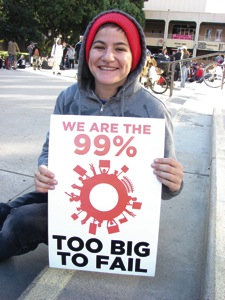
The major challenge for all occupiers, LGBT included, has been the police. During my visit to the occupation, Deutsch counted roughly 25 officers with about 25-50 occupiers in the square.
“If you look around here right now, for example, there are four police officers over there [east end of the square] about 25 feet from us. There are three police officers at the [San Diego Civic Theatre] entrance. They’re three or four in front of the Tattoo EXPO [in the San Diego Concourse]. There’s usually a few sitting in that [Civic Center Plaza] building with some kind of sniper weird gun. There are I don’t know how many police officers in the [Concourse] parking garage over there,” Deutsch said.
Deutsch said occupiers’ problem with the police began on day one of the occupation with police telling occupiers they had to move their tents.
“They’d say, ‘You have to move your tent over there’ and then there would be a shift change, and some police would say, ‘You have to move your tent three feet to the left.’ And then suddenly it was, ‘You can’t allow any more tents in.’ A day later, they said, our ‘chairs must be removed,’ and then they said, we had ‘too many tents.’ And then it became a ‘sanitation issue.’ This was confusing because we had a sanitation committee cleaning several times a day. And then it was eventually, ‘You can’t have any tents here.’ A few days later, we couldn’t have sleeping bags, and now you literally can’t put your physical body on the ground; you can’t put your backpack or purse down without threats to be arrested,” Deutsch said.
In less than two months since Occupy San Diego began, 120 people have been arrested, Rachel Scoma, CFAC programs director and volunteer attorney, said. She estimates that about 10 percent of those arrested are LGBT.
Besides moving or preventing protestors from assembling in the square, police have also used Mace and billy clubs against them. For example, Oct. 14, during their clearing of the square’s tent city, police “Maced, kicked, pushed and shoved several protestors,” Scoma said. Deutsch was one of those protestors.
“I was Maced while being choked by an officer,” Deutsch said.
For many protestors, it’s been hard to predict police behavior toward protestors on any given day.
“There have been days where they seem generally jovial, which makes the days when you get harassed for putting down your book bag even more annoying. I never know when I go down there whether or not its going to be a really tense situation or a really calm situation,” Zakiya Khabir, member of SAME and fellow “queer” occupier, said.
“It’s all based on the police mood and the protestors respond in kind,” Khabir said. “When the police are tense and aggravated, the protestors are tense and aggravated.”
Deutsch said protestors, for the most part, have remained calm and peaceful.
“Everyone I know, everything I’ve seen, everything I’ve witnessed has been insanely peaceful. Even when people are getting choked; even when people’s partners are being arrested. I’ve seen people literally be sleeping on the ground and be dragged by their pants until their pants are pulling down and their behinds are exposed. I don’t think you can get more peaceful than that,” Deutsch said.
Response
In response to police treatment of protestors, occupiers have requested the City Council, at several council meetings, to endorse a space for protestors to occupy without the threat of arrest. Two weeks ago, CFAC went canvassing in the downtown and Uptown areas asking pedestrians to sign a petition requesting the Council to support a space for occupiers. Deutsch said, canvassers gathered 400 signatures during the two-hour event. So far, the Council has yet to place Occupy’s request on a meeting agenda. City Council President Tony Young, who sets the Council’s meeting agenda, did not return my call for comment regarding why the Council hasn’t placed Occupy on its meeting agenda.
CFAC also recently filed a temporary restraining order against the city and police for preventing occupiers from setting their personal belongings on the ground.
“We are attacking the city and police for denying protestors their First Amendment rights, the right to free speech and the right to assemble,” Scoma, the CFAC volunteer attorney, said, who was one of two attorneys representing the occupiers in the suit. “Protestors should be able to assemble and protest at any public place.”
However, last week, a judge denied CFAC’s request for the order.
Bryan Pease, lead attorney in the suit, told the Union Tribune that he and others will continue to monitor police treatment of occupiers and may request another restraining order.
Authorities say it’s not a matter of occupiers not being able to protest, but rather it’s about them not following the law when they demonstrate.
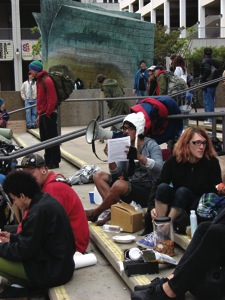
“The mayor supports the right to protest, but it must be done in a way that’s compliant with the law and does not jeopardize public health or public safety,” Darren Pudgil, director of communications for Mayor Sanders, said.
“Those that peacefully protest, they are allowed to, but you can’t bring in a camp site, you can’t dump all your personal property, and you can’t say, ‘I’m going to break the law to make my point,’” Andra Brown, media spokesperson for the San Diego Police Department, said. “If you’re going to break the law to make your point, we know how to deal with law breakers.”
Hope
It’s now early December and occupiers are celebrating the two-month anniversary of the local occupation. The tent city is a distant memory, but occupiers continue to hold teach-ins, committee meetings and various demonstrations at the square, and organizers say they are still well attended. And even though their ability to assemble has increasingly been restricted by police, LGBT occupiers remain positive and hopeful.
“There is a positive spin downtown where people are saying, ‘Don’t worry, by spring we’ll be reoccupying, we’ll have a space.’ I think that’s really motivational because people know this will be going on still in the spring,” Deutsch said.


